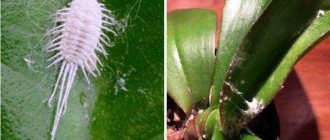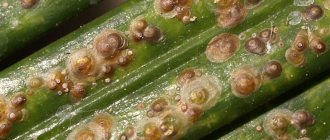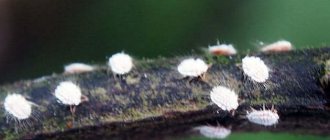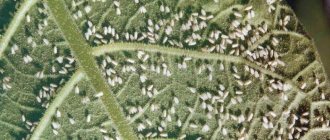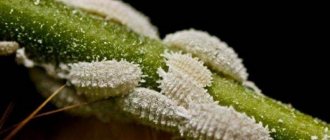Scale insects on house plants, beds or garden trees can cause a lot of trouble. These insect pests damage the leaves, trunks, fruits and branches of many plants. At the height of the gardening season, we fight scale insects competently!
If you find small yellow-brown plaques on your plants, it’s time to sound the alarm. Do not be fooled by their “frivolous” size - in agricultural regions, when some types of these crumbs are discovered, strict quarantine is introduced. In just a few years, scale insects can destroy even a small tree, let alone your orchid or beetroot.
Let's get to know the enemy better so we know exactly how to fight against the scale insect.
Varieties of scale insects living in the garden and vegetable garden
Each type of insect has its own size and color. The only thing they are similar to each other is the presence of a wax shield on the body. By the way, this is where the name of the parasite comes from. There is no need to list all types. It is better to consider several varieties of insects that are most commonly found in the region.
Comma-shaped scale
Comma scale insects bear little resemblance to insects because they do not have eyes or limbs. In appearance, they look more like grown spots on the bark. The females are the most dangerous for vegetation; their body is shaped like a comma. Color – milky white. The length of the scutellum is at least 4 mm, brown in a living specimen and dark brown in a dead one.
Female comma scale insects do not move. Their main purpose is to breed offspring. One female is capable of laying up to 100 eggs, after which she dies. Under its shield, eggs can survive even in severe frosts. When the air temperature reaches +8, the first apple blossoms and small insects appear.
The young offspring are called wanderers because they quickly move along the trunks in search of food. At this point they are easiest to notice, as they are yellowish in color and no more than 3 mm long.
For reference! Lack of food for more than 48 hours is considered fatal for young scale insects.
Willow scale
The willow type of insect differs from the previous one in its wide and flat shield. Color – white or with a grayish tint. The female of this species has a red and yellow body. The eggs are red-violet in color. The ideal period for laying eggs is from August to September. One female individual is capable of laying from 20 to 70 eggs, which remain under the shield for the winter.
False California parasite
The false Californian scale insect is not only a fruit pest. She likes elm, poplar and linden. It is also an acacia parasite that affects many other tree crops. A round or oval-shaped bug can have two shades of shield. For wintering, the larvae remain on the bark of trees, and with the arrival of spring they begin to disperse, sticking to the bark. At the same time, females begin to lay eggs with new generations.
Acacia false shield, or common
The acacia, or ordinary, type of scale insect is distinguished by its reddish color and semicircular shield. Its target is fruit trees and bushes of stone fruit crops. Most often, this is a grape pest that is difficult to notice and remove. Females like last year's grapevine
Living on grapes, the parasite quickly becomes covered with a hard shell. This is a necessary condition for the preservation of offspring, since after death the female’s shield protects small scale insects. With the onset of warming, the first small insects appear and scatter around the area in search of food. With the arrival of autumn, all young individuals immigrate to annual shoots, which allow them to survive without protection until spring.
Plum false scale
The plum false shield can have a round, elongated oval or oval body. The length of a mature female can reach 9 mm. The shield can be moderately or strongly convex, hemispherical or spherical.
Like most scale insects, this species lays eggs underneath itself, hiding the offspring behind the shell. Gooseberries, figs and other rare shrubs often suffer from this type of pest. Also at risk are outdoor and indoor plants, such as cinquefoil, Decembrist or dracaena.
Reasons for appearance
A healthy plant is capable of producing antibodies against pests. They are able to naturally create a protective layer and repel insects. In this case, the scale insect appears on trees that have weakened immunity.
Most often, the parasite starts when there is insufficient lighting, watering or severe dry air. Scale insects are not able to influence the fruiting and development of a healthy and well-groomed plant.
What danger does it pose to house flowers?
Scale insects live in colonies. They absorb all the substances necessary for the normal functioning of the flower.
Adult female scale insects are tightly attached to the surface of the plant, thereby ensuring the safe existence of eggs and larvae. Red-brown or yellow spots remain in these areas.
After some time, the first signs of pathology in the life of the plant appear. The leaves begin to turn yellow, the stems develop incorrectly, and the buds fall off. Over time, the diseased plant stops growing, and its stems become bare. Then the flower gradually fades and dies.
What trees and shrubs are affected by the pest?
There are practically no restrictions for this parasite among trees and bushes. The soil, garden, winter greenhouse and indoor flowers may also be attacked.
Most often, the comma-shaped insect affects:
- apricot;
- quince;
- thorn;
- linden;
- plum;
- roses;
- honeysuckle;
- peach;
- hawthorn;
- mulberries;
- rowan;
- cotoneaster;
- lilac.
The scale insect is also found on pear, cherry and sweet cherries. Currants, raspberries, cherry plums and apple trees are not all that the insect loves. There are more than a hundred names of flora that scale insects can feed on. Some varieties are capable of attacking even plants that secrete poison for protection.
Which indoor plants are at risk?
Scale insects are dangerous for many plants. Leaves with a smooth surface, which is easier for parasites to attach to, are most often affected. However, the fleecy leaves of Saintpaulia (violet) may also suffer.
Different types of insects have their own preferences:
- mulberry scale is dangerous for ornamental shrubs and fruit crops;
- red orange affects all varieties of citrus fruits;
- cactus prefers to settle on domestic cacti and succulents (aloe, kalanchoe, sansevieria, crassula);
- brown is found on ficus, oleander, camellia, dracaena, hibiscus, boxwood;
- the tropical scale insect is polyphagous, it often settles on roses, palm trees, orchids, as well as aroids, which include Dieffenbachia and spathiphyllum;
- The olive scale insect most often affects laurel, pomegranate, oleander, crassula and citrus fruits.
Signs and danger of insects for fruit and berry plants
Despite their small size, scale insects can cause enormous damage to garden vegetation. Their danger is that they feed on juices until the shoots die. During the process of infection, the leaves begin to fall off and dry out, this is a sure sign of an attack. Before using chemicals, insects should be removed from protection by mechanical means. Otherwise, chemical treatments will be ineffective.
Most often, you can notice the presence of the parasite in the spring, when small active insects that do not have wax armor appear. In search of food, newborn bugs scamper along tree trunks, branches and foliage. At this moment, it is best to start the fight using chemistry. In this case, adult individuals can be seen attached to the lower part of the leaves, in the places where the leaves adjoin the branches or trunk. Inspecting the leaves, you can see small spots that will also be on the trunks.
Types of false scale insects
The false scale insect is also distinguished by its great species diversity.
- Soft. Loves orchids, aroids, citrus, palm plants. It appears in the form of sugary secretions on the leaves and sticky deposits on the glass.
- Acacia. Damages currants, plums, gooseberries, peach, cherries, apple trees and others.
- Spruce. Based on the name, it is clear that the target of the attack is coniferous plants.
- Plum. Appreciates the juice of stone fruits and rose flowers.
Soft scale insect
Acacia false scale
Means for combating scale insects
Plum, acacia and other types of scale insects have reliable protection - a wax shield. This armor allows insects to protect themselves from the effects of poisons. Fighting scale insects in the garden with chemicals is quite difficult and not always effective. Despite this, it is possible to destroy an insect even in the last stages of life.
For information! You cannot remove insects with your hands, because by removing one individual, you can release dozens of babies from under the shell, which will hide and continue destruction.
Chemicals and biological products
Several methods can be used to control insects:
- folk remedies;
- chemicals;
- mechanical cleaning.
The choice of methods is usually influenced by the level of infestation of vegetation, the population of the insect species and the number of crops affected. There are a number of chemicals that kill insects after several treatments without harming the plant itself and the fruit. To achieve better results, you can combine different types of chemicals.
"Aktellik"
Refers to phosbecides. It has an unpleasant odor and is considered poisonous to animals and humans. The chemical must not be used indoors. Manufacturers claim effective destruction of parasites after the first use. The product creates a protective layer, preventing the reappearance of parasites. Actellik is often used to treat seeds immediately before planting.
"Bitoxibacillin"
The product is based on live bacteria and is not hazardous to humans or animals. Bitoxibacillin is odorless and has a detrimental effect on scale insects. Treatment with this product is carried out several times with a short break. Properly process gardens at a temperature of at least +18. In the process of exterminating insects, we must not forget about the means of protecting the skin and mucous membranes.
"Bankol"
It is considered a contact-intestinal remedy against rodents and scale insects. It has a paralyzing effect on the nervous system of the parasite, as a result of which it dies within a few days after treatment. The drug is considered non-toxic to humans, has no odor and is not washed off by rainwater. The only negative is that it is not recommended to cultivate orchards.
"Aktara"
Aktara is considered one of the most effective means in the fight against scale insects. The substance is not capable of causing addiction to parasites and has a rather pungent odor. The chemical is not recommended for use in the area where bees are located. Do not use in closed or residential areas.
Folk recipes
Most often, folk methods are used to combat scale insects on indoor plants, greenhouses and small trees and bushes in the garden. If the parasite infestation is minor, the accumulation areas must first be washed with a soapy solution.
You can use a warm shower to wash off the pests and use a soft toothbrush (like a toothbrush) to clean the leaves as you go. When mechanically cleaning leaves, branches and trunk, the brush can be moistened in an alcohol solution (diluted with water and alcohol in a ratio of 2:1).
A solution of peroxide and alcohol is considered effective in the fight against the parasite. This mixture, harmless to humans, can corrode insects, leading to their death. In addition, this product is a plant food that accelerates growth and strengthens roots. To prepare it you need to take 3% peroxide - 50 ml, a liter of water and 2 tablespoons of alcohol
All components are diluted in water, soap or other soapy substance is added as an adhesive. The finished mixture can be used to treat plants. The solution is prepared immediately before use to avoid oxidative processes.
The following folk recipes for spraying can be a good alternative to chemicals:
- Garlic and soap are crushed and mixed with water in a 1:1 ratio. A day after treatment, the plant is washed with a stream of water. Treatment is repeated every 3 days until the insects disappear;
- onion tincture. Peel and chop 4 onions, add a small amount of water and leave for several hours;
- infused hot pepper. You need to take 200 grams of pepper per 2 liters of water. Boil the pepper pieces in water for no more than 15 minutes, then leave for 24 hours. You need to prepare the spray mixture by taking 10 grams of tincture and 5 grams of soap per 1 liter of liquid.
Preventive actions
Following some rules for caring for indoor plants will help prevent the appearance of pests such as scale insects. When purchasing new flowers, they should not be immediately installed next to indoor plants. It’s better to play it safe and quarantine them in a separate place for a while. To prevent the appearance of pests, it is better to regularly ventilate the premises and spray indoor plants with water.
Scale insects are dangerous because they suck out all the juices from the plant, which leads to the death of indoor flowers. Untimely destruction of such parasites causes significant harm to your home flower collection. Everything that is grown with such difficulty can instantly turn into sick, dying plants that can no longer be saved. Therefore, regular inspection of indoor flowers will help to detect dangerous insects in a timely manner and can protect ornamental plants from death.
Scale insects pose a great danger not only to indoor ornamental plants, but also to garden flowers. If the parasite is not identified in time, it will destroy almost all flowers and other garden crops in the garden.
https://youtube.com/watch?v=8PgAPSKOjqU%3Frel%3D0
Rules for processing the garden and vegetable garden
If scale insects are found on an orchid and other inhabitants of the greenhouse, you can get rid of it with your hands. For this purpose, you need to inspect all the bushes and flowers, carefully separate the infected parts and take measures to destroy them. It is preferable to treat the affected areas with chemicals first to prevent the parasites from escaping. Afterwards the remains are burned.
Another way to combat insects is to attract beneficial predatory mosquitoes. After the scale insects in the area are over, these insects will independently continue to look for food.
These include:
- wasps – parasites;
- ladybugs.
If it is necessary to treat an orchard in order to preserve fruits and pets, you can initially try methods that have little toxicity. If their effectiveness is not noticeable, they should be treated with insecticides and chemicals.
If there are crops left in the garden that are not affected by scale insects, there is no need to spray them with chemicals. It will be enough to water them well, using biological material for fertilizer. You can also cultivate the ground around it to prevent scale insects.
Preparatory work
Scale insects are a pest that is quite difficult to destroy. For this reason, methods of combating scale insects must be chosen very carefully, since their shell reliably protects not only their offspring. It would be a good idea to get a metal brush and scraper, since the bark will need to be cleaned by hand.
Mature plants are quite difficult to clean from the parasite mechanically. Therefore, you also need to use chemicals.
It is necessary to strictly adhere to processing times, since a large part of success depends on this. Do not forget that chemical compounds can harm not only insects. Negative effects can be had on vegetation and humans, which makes it necessary to use special equipment. It is best to get gloves, goggles and a respirator to protect your mucous membranes. Having a quality sprayer is also important.
The main task of preparation is the purchase of the correct, effective chemical substance. It is necessary to purchase only approved drugs, since there are many fakes and cheap analogues that do not have any effect on parasites.
Treatment of plants and trees
Mechanical impact will help deprive the laid eggs of protection. In case of severe damage by scale insects, it may be necessary to remove the infected parts of the plants or remove the plantings completely. It is preferable to burn branches and other affected areas.
To combat the parasite on young seedlings, use mechanical cleaning and then wash them with laundry soap. The soil around the infected tree must be treated with a chemical. After several days, when the insects die out, it is best to throw away the top layer of soil and fill in a new one.
It is correct to spray the affected vegetation in the spring, when insects emerge from the protection of the shield. The best temperature for processing is considered to be at least +4 degrees Celsius. When spraying, it is ideal to completely cover the vegetation with a chemical solution. The systematics and number of treatments are determined by the number of insects and affected areas.
It is better to plan subsequent pest control activities so that they occur during the hatching period of the offspring, until they are covered with a shell. In this case, no more than a month should pass between sprayings.
Treating trees with chemicals after the appearance of the shield in young individuals is ineffective.
We introduce specialized preparations into the soil
Garden and vegetable soil must be treated, even if no insects are seen there.
You need to get rid of scale insects by watering the soil with chemicals:
- Confidor is used to spray or water vegetation. The drug can be used for a long period. The main thing is that the poison accumulates in the leafy part, which means that the fruits do not absorb it. This procedure allows you to cultivate your home garden without harm or loss of harvest;
- Aktara shows its effectiveness best when applied to the soil, but can also be used for watering vegetation. When fertilizing the soil, the protective properties are maintained for 2 months; for comparison, spraying allows protection for only a few weeks.
Habitat
The scale insect is distributed all over the world; many species came to us from other continents. Insects have many ways to expand their habitat. From remote regions and other countries, the pest comes along with plants brought by importers. It is not easy to detect it in small quantities, so when buying a flower in a store there is no guarantee that the pest will not enter the house.
One female is enough, which can produce offspring without an individual of the opposite sex.
Scale insects live on indoor flowers and in the garden. Plants wither and die due to pest invasion. You can bring insects home in the following ways:
- pick flowers from the field;
- buy an infected plant, from where scale insects will move to others;
- pests can migrate from neighbors through the balcony where flowers are displayed in the summer;
- rarely, but it happens that they are carried by the wind.
Interesting! Pests are able to move to new places along with other insects that can travel long distances.
Prevention of re-infection
When using preparations for scale insects on fruit and other trees, you need to carefully treat them and prevent their reappearance.
Prevention can be used as the initial method of removing parasites:
- It must be remembered that sexually mature individuals are inactive, which means that it is necessary to stop planting new trees for a while. Especially in close proximity to infected crops;
- buying seedlings from reliable sellers is also a kind of insect control. It must be remembered that most cases of infection occur due to the acquisition of infected seedlings;
- autumn should be accompanied by digging up the soil, and spring by removing the remains of leaves and infected parts of trees and other vegetation.
These simple methods protect the area from the scourge of scale insects. Periodic inspections of the plant will prevent parasites from multiplying and will help preserve the harvest. Fighting scale insects is not an easy task, however, comprehensive control measures have a noticeable effect and allow you to achieve good results.
False scale insects on conifers, how to quickly and effectively get rid of the insect, read more in this article.



